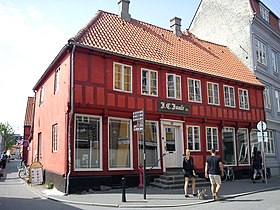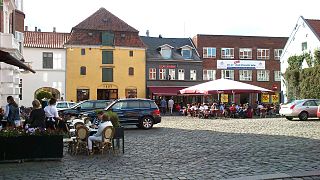
Latinerkvarteret in Aarhus, is the oldest part of the city and is itself part of the inner city. The quarter comprise the streets of Badstuegade, Klostergade, Volden, Studsgade, Borggade, Rosensgade, Mejlgade and Graven, with Pustervig Torv as the main square.

The Aarhus School of Architecture was founded in 1965 in Aarhus, Denmark. Along with the Royal Danish Academy of Fine Arts, School of Architecture in Copenhagen, it is responsible for the education of architects in Denmark. The school has approximately 750 students.

Kærbygård is a manor house and a listed building in Aarhus Municipality, Denmark. The manor was built in 1768 and was listed by the Danish Heritage Agency on 16 April 1990. The estate has been an active farm since it was built.

Aarhus Old City Hall is the former city hall of Aarhus, Denmark, and a listed building. The city hall was built in 1857 and was listed in the Danish national registry of protected buildings and places by the Danish Heritage Agency on 18 March 1996. It is the second, and oldest preserved, city hall of Aarhus.
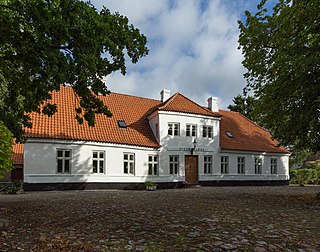
Jarlsminde is a farm and a listed building in Aarhus, Denmark. The farm was built in 1798 and was listed in the Danish national registry of protected buildings and places by the Danish Heritage Agency on 3 June 1997. The farm is situated in the suburb Stavtrup about 7-8 km. south-west of the city centre of Aarhus where it sits on a hill with a view of Brabrand Lake and the large urban areas on the other side of it.

Mejlen or Asylet Børnely is a house, former asylum and a listed building in Aarhus, Denmark. The house was built in 1768 and was listed in the national Danish registry of protected buildings and places by the Danish Heritage Agency on 8 November 2008. The building originally functioned as a kindergarten but is today home to an art gallery.

Badstuegade 1H is a house and a listed building in Aarhus, Denmark. The house was built in 1809 and was listed on the Danish registry of protected buildings and places by the Danish Heritage Agency on 7 October 1970. The house is situated in the historic and central Latin Quarter neighbourhood on Badstuegade by Pustervig square.

Hald's House is a 4-winged house and a listed building in Aarhus, Denmark. The house was built in 1870 and was listed on the Danish registry of protected buildings and places by the Danish Heritage Agency on 7 October 1970. The house is situated in the central Indre by neighborhood on Vesterport.
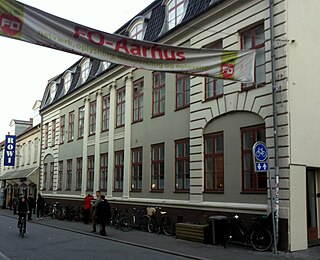
Herskind's House is a house and a listed building in Aarhus, Denmark. The house was built in approximately 1850 and was listed on the Danish registry of protected buildings and places by the Danish Heritage Agency on 2 October 1970. The house is situated in the historic Indre by neighborhood on Frederiksgade, close to the City Hall.

Mejlgade is a street in Aarhus which runs north to south from Østbanetorvet to Skolegade and intersects Nørrebrogade. The street is situated in the historic Latin Quarter neighborhood and has the highest number of historic and listed buildings in the city. Mejlgade is one-way and no-parking zone for cars for most of its length and pedestrians and cyclists are given priority. The single lane is tiled and a part of the Cykelringen bicycle ring which circumnavigates the city center. Mejlgade has a high number of small specialty shops and some cafés and bars.
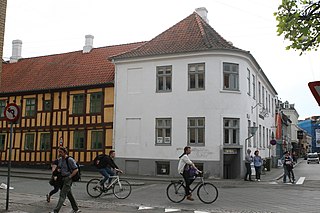
Aarhus Art Academy is an art school in Aarhus, Denmark. The school resides in a listed building on Vestergade 29 in the old medieval inner city, comprised by the neighborhood of Indre By. The building was listed on the Danish registry of protected buildings and places by the Danish Heritage Agency on 3 December 1924. The school offers a 4-year arts programme and a number of courses in sculpting, painting, design, ceramics, photo and webdesign.

Mejlborg is a residential building in Aarhus, Denmark. The building is situated in the Nørre Stenbro neighborhood on Kystvejen 59-65 and Mejlgade 92 in the city center. It was the first large, privately built apartment complex in the city and a social hub for the upper class in the early 20th century. Mejlborg is named for the adjacent Mejlgade street. "Mejl" is derived from the old-Danish word for middle and "borg" means castle making Mejlborg the middle-castle or the castle in the middle.

Vestergade is a street in Aarhus, Denmark, which runs east to west from the central square of Store Torv to the city park of Åparken at Carl Blochs Gade, intersecting the main streets of Grønnegade and Vester Allé along its course. Vestergade begins in the Indre By neighborhood and ends in neighborhood of Vesterbro, close to CeresByen. Vestergade has some of the best preserved 18th-century merchant estates in Aarhus and a history of creativity and artistic expression.

Studsgade is a street in Aarhus which runs north to south from Nørreport to Klostergade and Graven. The street is situated in the historic Latin Quarter neighborhood and is home to four listed buildings. The street has existed since at least the 1400s, when it was known as Sturisgade and Stus Gaden, probably for councillor Jep Sture, who had a house there. It was officially given its current name in 1796.

Klostergade is a street in Aarhus which runs east from Grønnegade to Studsgade, intersecting a number of streets.
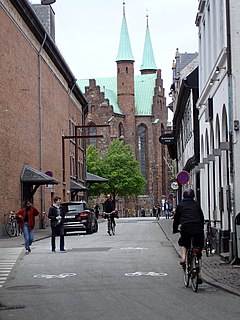
Skolegade is a street in Aarhus, Denmark which runs north to south from Mejlgade to Mindebrogade. The street is situated in the Midtbyen neighborhood. Skolegade is home to two listed buildings and runs past the Aarhus Theater. Skolegade is an area with many bars and eateries, and it has a lively nightlife. The street is from at least medieval times with many historic buildings.

The architecture of Aarhus comprises numerous architectural styles and works from the Middle Ages to present-day. Aarhus has a well-preserved medieval city center with the oldest dwellings dating back to the mid-1500s and some ecclesiastical structures such as St. Clemen's Cathedral and numerous smaller churches that can be traced back to the 1100s. The industrialization of the 19th and 20th centuries left distinctive industrial structures, important National romantic works and some of the best examples of Functionalist architecture in the country. The history of the city as a Viking fort is evidenced in the street layout of the Latin Quarter, the wider Indre By neighborhood testifies to its later role as a Market town and center of commerce while the Frederiksbjerg, Trøjborg and Marselisborg districts showcase the first cohesive urban planning efforts of the early 20th century.

Vestergade 58 is a listed building in Aarhus, Denmark. The listing includes 6 buildings on Vestergade in Aarhus, in the Indre by neighborhood, The buildings were constructed around 1761 and were listed by the Danish Heritage Agency in 1950. The buildings were originally a merchant's mansion used for trade and storage but in the 1960s it became a cultural focal point in Aarhus as Musikernes Hus.
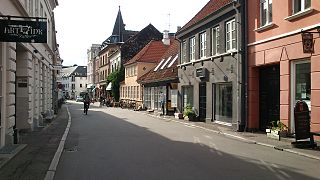
Graven is a street in Aarhus, Denmark. Graven was created some time before year 1500 on and in the northernmost moat used to defend the early Viking settlement. It is one of the oldest streets in the city and used to mark the northern city limits along with Klostergade. Graven runs 220 meter west to east from Klostergade to Mejlgade and is situated in the historic Latin Quarter neighborhood. Graven is fairly narrow and is a designated one-way street for motorized traffic in the direction of Mejlgade towards Klostergade. Graven is characterized by low housing, cafés and speciality shops, and has much foot and bicycle traffic. As Klostergade and Mejlgade, Graven is a shared bikeway, part of the city's bicycle infrastructure network.

Frederiksgade is a street in the Indre By district in Aarhus, Denmark which runs north to south from Åboulevarden to Frederiks Allé. Frederiksgade is a major thoroughfare for pedestrians and cyclists and it connects Immervad to ARoS Aarhus Art Museum and the City Hall and Concert Hall parks. The street is fairly narrow and the architecture is primarily late 19th century to early 20th century.
